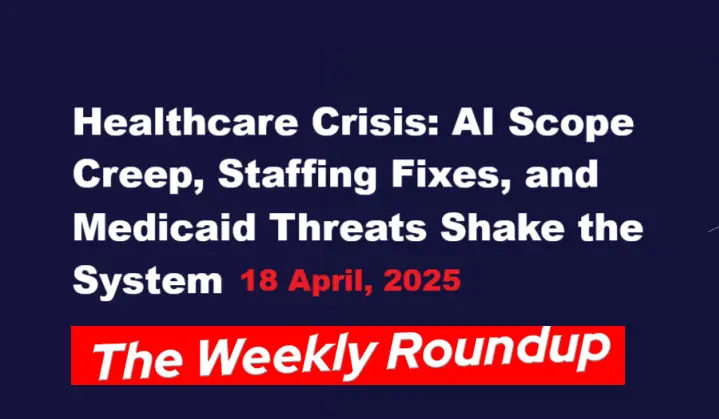
The Weekly Roundup 18th April 2025
Healthcare Crisis: AI Scope Creep, Staffing Fixes, and Medicaid Threats Shake the System
Hospitals face a perfect storm: AI scope creep alarms IT leaders, innovative staffing models save the day, and Medicaid cuts loom large. Here’s how the industry is fighting back.
It’s 4 a.m., and Dr. Sarah Thompson, an oncologist at Lee Health Cancer Institute in Florida, is preparing for a grueling 12-hour shift. She’s not just battling cancer but also a staffing crisis that’s left her team stretched thin. “We were drowning,” she says, her voice heavy with exhaustion. But a recent shift-scheduling overhaul at Lee Health has changed that, balancing workloads and giving doctors like her a fighting chance to focus on patients. This is just one piece of a chaotic puzzle shaking healthcare in 2025, as hospitals grapple with AI overreach, Medicaid threats, and a mental health crisis that’s pushing the system to its limits.
The healthcare industry is at a crossroads, and the stakes couldn’t be higher. At MetroHealth in Ohio, IT executive Dr. Yasir Tarabichi is sounding the alarm on “AI scope creep,” a growing concern as hospitals rush to scale AI pilots. “We’re spending millions on AI vendors, but what happens when these tools overpromise and underdeliver?” he told Becker’s Hospital Review in April 2025. His fear is real: AI systems, meant to streamline diagnostics and billing, are creeping into untested areas, risking clinician burnout and patient safety. MetroHealth’s cautious approach—partnering with flexible vendors and upskilling staff—offers a blueprint, but scaling AI without chaos remains a tightrope walk.
Meanwhile, innovation is saving lives elsewhere. In California, three health systems—Kaiser Permanente, Sutter Health, and Dignity Health—have slashed thousands of bed days by leasing nursing facility beds, a move that frees up hospital space for critical cases. “It’s a game-changer,” says nurse manager Maria Lopez in Sacramento. “Patients get rehab faster, and we’re not turning away emergencies.” This model, detailed in a March 2025 report, shows how creative partnerships can ease overcrowding, but it’s not a cure-all. Rural hospitals, strapped for cash, can’t always afford such leases.
The financial squeeze is tightening. The Centers for Medicare & Medicaid Services (CMS) proposed a 2.4% pay increase for hospitals in 2026, but hospital leaders are crying foul. “It’s a drop in the bucket,” says Dr. Emily Chen, CEO of a small hospital in Fresno. With inflation soaring and nurse salaries up 10% since 2023, the update won’t cover costs. Worse, California faces a Medicaid crisis: a new analysis warns that federal work requirements could strip coverage from millions, hitting low-income families hardest. “This isn’t just numbers—it’s people’s lives,” Chen says, her frustration palpable.
On the policy front, CMS Administrator Mehmet Oz is pushing President Trump’s price transparency order, aiming to empower patients with clear cost data. Announced in early 2025, the initiative has sparked hope but also skepticism. “Transparency sounds great, but will it lower prices?” asks patient advocate Lisa Rivera. Hospitals, already drowning in paperwork, worry about compliance costs. Still, Oz’s vision could reshape how patients shop for care—if it delivers.
The mental health crisis is another battleground. Hospitals like SSM Health in Missouri are adopting virtual nursing and “hospital-to-home” programs to support patients with depression and anxiety. A 2024 AHA report highlights a 30% drop in readmissions for mental health patients under these models. “We’re finally treating the whole person,” says therapist James Carter. But with 15 physician specialties, including psychiatry, reporting pay drops from 2023 to 2024, attracting talent is tougher than ever. Dermatology took the biggest hit, down 12%, per a recent survey.
Pharma isn’t helping. Pfizer’s decision to halt its GLP-1 drug danuglipron after a liver injury scare in 2025 has left obesity patients reeling. “We need options, not setbacks,” says Rivera, who struggles with weight management. The drug’s failure underscores the risks of rushing innovation—a lesson hospitals scaling AI must heed.
Despite the chaos, there’s hope. Lee Health’s staffing fix, California’s bed-leasing model, and SSM’s mental health programs show that grit and ingenuity can move the needle. But the system needs more: fair funding, ethical AI, and policies that protect the vulnerable. Dr. Thompson sums it up: “We’re fighting for our patients, but we can’t do it alone.” As healthcare teeters on the brink, the question isn’t just how to survive—it’s how to build a system that thrives.
Sources:
Becker’s Hospital Review, April 2025
American Hospital Association, October 2024
CMS.gov, 2025 fiscal proposals
California Medicaid analysis, 2025